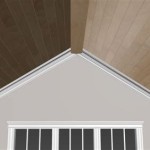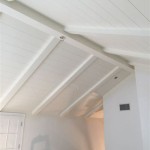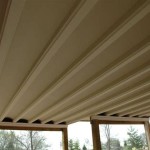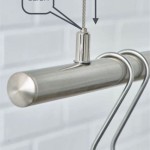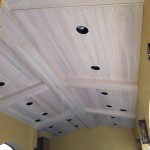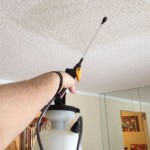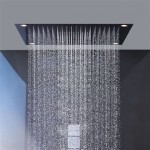How to Remove Brown Water Stains From Popcorn Ceiling
Popcorn ceilings, also known as acoustic ceilings, were a popular choice in residential construction for many years, primarily due to their sound-dampening and texturing qualities. However, they are also known for their susceptibility to water damage, which manifests as unsightly brown or yellowish stains. These stains can detract significantly from the overall appearance of a room and, more importantly, indicate an underlying plumbing issue or roof leak that requires immediate attention. Addressing these stains effectively requires a careful approach, as popcorn ceilings are fragile and easily damaged.
Before attempting any stain removal methods, it is crucial to identify and resolve the source of the water leak. Ignoring the underlying cause will only result in the stains reappearing shortly after cleaning. Common sources of water leaks include leaky roofs, plumbing issues in the bathroom or kitchen above, and condensation buildup due to poor ventilation. Engage a qualified professional to inspect the roof or plumbing system to diagnose and repair the problem. Once the leak is fixed, allow the ceiling to dry completely before proceeding with stain removal. Attempting to clean a still-damp popcorn ceiling can exacerbate the damage and make the stain more difficult to remove.
Understanding the Composition of Popcorn Ceilings
Popcorn ceilings are typically composed of a textured material, often containing polystyrene or vermiculite aggregate, sprayed onto a drywall or plaster base. The texture is what gives it the characteristic "popcorn" appearance. The porosity of this material makes it particularly absorbent, which is why water stains become so prominent. Furthermore, older popcorn ceilings may contain asbestos, a known carcinogen. Asbestos was commonly used in construction materials until the late 1970s, and disturbing asbestos-containing materials can release harmful fibers into the air. Before attempting any DIY removal or cleaning of a popcorn ceiling in a home built before 1980, it is essential to have it tested for asbestos by a certified professional. If asbestos is present, it is strongly recommended to hire a licensed asbestos abatement contractor to handle the removal or repair to ensure safety and compliance with regulations.
Even if asbestos is not present, the textured surface of popcorn ceilings presents a cleaning challenge. The loose texture can easily crumble or detach if subjected to excessive pressure or moisture. Therefore, gentle and patient techniques are necessary to avoid further damage. Avoid abrasive cleaners and scrubbing motions, as these can easily dislodge the texture and create a larger, more noticeable problem. Instead, focus on gentle blotting and light application of cleaning solutions.
Testing Cleaning Solutions on an Inconspicuous Area
Before applying any cleaning solution to the stained area, it is essential to test it on an inconspicuous area of the ceiling, such as in a corner or behind a light fixture. This will help determine if the cleaning solution will discolor or damage the ceiling texture. Apply a small amount of the solution to the test area and let it sit for a few minutes. Then, gently blot the area with a clean, damp cloth. Observe the test area for any adverse reactions, such as color changes, crumbling, or detachment of the texture. If any of these occur, discontinue use of that cleaning solution and try a different option or consult a professional cleaning service.
When testing cleaning solutions, it is also important to consider the overall appearance of the ceiling. Even if the cleaning solution does not damage the texture, it may still leave a subtle discoloration or change in sheen. This can be particularly noticeable if the rest of the ceiling is old or faded. In some cases, it may be necessary to repaint the entire ceiling to achieve a uniform appearance after stain removal.
Effective Methods for Removing Brown Water Stains
Several methods can be employed to remove brown water stains from popcorn ceilings, ranging from gentle solutions to more aggressive approaches. The best method will depend on the severity of the stain and the overall condition of the ceiling. Always start with the gentlest method and gradually increase the intensity as needed.
Method 1: Dry Sponge
For light stains, a simple dry sponge can be surprisingly effective. Use a clean, dry sponge, preferably one made of natural rubber or foam. Gently blot the stained area with the sponge, applying light pressure. Avoid rubbing or scrubbing, as this can damage the texture. The sponge will absorb some of the stain, gradually lightening its appearance. Repeat this process several times, using a clean area of the sponge each time, until the stain is minimized. This method is particularly effective for fresh, superficial stains.
Method 2: Mild Soap and Water Solution
For more stubborn stains, a mild soap and water solution may be necessary. Mix a small amount of mild dish soap with warm water. Use a spray bottle to lightly mist the stained area with the solution. Avoid saturating the ceiling, as excessive moisture can cause damage. Let the solution sit for a few minutes, then gently blot the area with a clean, damp cloth. Repeat this process several times, using a clean area of the cloth each time, until the stain is reduced. Finally, blot the area with a dry cloth to remove any excess moisture.
Method 3: Stain-Blocking Primer
If the above methods fail to remove the stain completely, a stain-blocking primer may be required. This is a more aggressive approach, as it involves painting over the stained area. However, it can be effective for covering persistent stains that cannot be removed by other means. Choose a high-quality stain-blocking primer specifically designed for ceilings. Apply the primer to the stained area using a small brush or roller, being careful not to disturb the texture of the ceiling. Allow the primer to dry completely according to the manufacturer's instructions. Then, apply a coat of ceiling paint that matches the existing color of the ceiling. This method is best suited for small, localized stains.
Method 4: Hydrogen Peroxide Solution
A solution of hydrogen peroxide diluted with water can sometimes be effective for lightening brown water stains. Mix equal parts of 3% hydrogen peroxide (the type typically found in drugstores) with water. Lightly spray the solution onto the stain, being careful not to oversaturate the ceiling. Allow the solution to sit for 10-15 minutes, then gently blot with a clean, damp cloth. Repeat as needed. This method can have a bleaching effect, so be sure to test it in an inconspicuous area first. Always wear gloves and eye protection when working with hydrogen peroxide.
Addressing Deeply Embedded or Extensive Stains
In cases where the water stains are deeply embedded or cover a large area of the ceiling, the above methods may not be sufficient. In these situations, professional cleaning services or ceiling replacement might be necessary. Professional cleaners have specialized equipment and cleaning solutions that can effectively remove stubborn stains without damaging the ceiling. They also have the expertise to identify and address any underlying moisture problems.
If the damage to the ceiling is extensive, or if the ceiling is old and brittle, replacement may be the most practical option. This involves removing the existing popcorn ceiling and installing a new ceiling surface. This is a major undertaking that should be handled by a qualified contractor, particularly if the old ceiling contains asbestos. The cost of ceiling replacement can vary depending on the size of the room, the type of ceiling material used, and the complexity of the job.
Preventing Future Water Stains on Popcorn Ceilings
The best way to deal with water stains on popcorn ceilings is to prevent them from occurring in the first place. Regular maintenance and proactive measures can help minimize the risk of water damage. Inspect the roof, gutters, and plumbing system regularly for any signs of leaks or damage. Address any issues promptly to prevent water from entering the ceiling. Ensure proper ventilation in bathrooms and kitchens to minimize condensation buildup. Use exhaust fans during showers and cooking to remove excess moisture from the air.
Consider applying a sealant to the popcorn ceiling to make it more water-resistant. This will create a barrier that prevents water from penetrating the texture and causing stains. Choose a sealant specifically designed for ceilings and follow the manufacturer's instructions carefully. Reapply the sealant every few years to maintain its effectiveness.
Safety Precautions When Working With Popcorn Ceilings
When working with popcorn ceilings, it is important to take certain safety precautions to protect yourself from potential hazards. Wear a dust mask or respirator to avoid inhaling dust and debris. Wear eye protection, such as safety glasses or goggles, to prevent particles from entering your eyes. Wear gloves to protect your hands from cleaning solutions and potential irritants. Cover furniture and flooring with plastic sheeting to prevent them from getting stained or damaged. Work in a well-ventilated area to avoid inhaling fumes from cleaning solutions or sealants.
If you suspect that your popcorn ceiling contains asbestos, do not attempt to remove it yourself. Contact a licensed asbestos abatement contractor to handle the removal safely and according to regulations. Asbestos exposure can cause serious health problems, including lung cancer and mesothelioma. It is always better to err on the side of caution when dealing with potentially hazardous materials.
Considerations for Repainting After Stain Removal
After removing water stains from a popcorn ceiling, repainting is often necessary to achieve a uniform appearance. However, repainting a popcorn ceiling requires careful planning and execution to avoid damaging the texture. Choose a paint specifically designed for ceilings, preferably one with a flat or matte finish to minimize glare. Use a paint roller with a long nap to reach into the texture of the ceiling. Apply the paint in thin, even coats, avoiding excessive pressure. Allow each coat to dry completely before applying the next.
Before repainting the entire ceiling, test the paint on a small, inconspicuous area to ensure that it matches the existing color and texture. If the color is not a perfect match, you may need to repaint the entire ceiling to achieve a uniform appearance. Consider hiring a professional painter to handle the repainting, especially if you are not comfortable working on ladders or dealing with paint fumes.

Popcorn Ceiling How To Remove An Ugly Stain Drywall Repairman Water Damage Repair

What Should I Do About Water Stains On A Popcorn Williams Painting

How To Fix Water Stains On Ceiling Leaks Super Easy Steps Abbotts At Home

We Have An Old Water Stain On Our Ceiling How Do I Cover It Hometalk

Super Easy Way To Remove Water Stains From Ceilings Without Paint 1 Step Abbotts At Home

Clean Dust And Debris From Popcorn Ceilings In Just Minutes Remove Dirt Old Ceiling

How To Remove Water Stains From Popcorn Ceiling At Home Without Paint Homax Texture Spray

How To Clean Popcorn Ceiling Molly Maid

Super Easy Way To Fix Water Stains On Ceiling Or Wall Without Painting It

How To Re Stucco Your Ceiling If There Is A Water Stain Hpt
Related Posts

